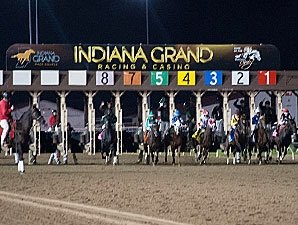Indiana Grand Hopes to Build on 2015 Meet


Indiana Grand Racing & Casino April 19 will begin its fourth season as the state's only Thoroughbred track with full fields and an average daily purse structure second only to Churchill Downs in the Midwest.
Indiana Grand in 2013 took over all the Thoroughbred and Quarter dates in the state, and Hoosier Park Racing & Casino became a Standardbred-only track. Before that, each track had flat and harness meets.
Purses last year at Indiana Grand for Thoroughbred racing averaged $226,290 per day over 114 programs, up from $215,868 in 2014, according to The Jockey Club Information Systems. Field size at the track has consistently been above eight horses per race over the past five seasons.
"We're excited about (the meet)," Indiana Grand director of racing Kevin Greely said. "The quality (of racing) has improved a little bit over the last couple of years. It's getting a lot tougher to win a race up here.
"Last year we were up 22% in handle, so the betting public is responding."
The purse for an open maiden special weight event this year is $32,000, while the purse for a comparable Indiana-bred race will be $34,000. Open allowance, maiden, and races for higher-priced claimers carry up to a 40% bonus for state-bred runners.
Indiana Grand has a total of 1,049 stalls, 948 for Thoroughbreds and 101 for Quarter Horses. Greely said more than 400 stalls have been added over the past 2 1/2 years.
Eighty stalls in the 120-barn receiving barn are reserved for shippers.
"A lot of times we're full (in the receiving barn)," Greely said. "We get more in July and August when we're not running head-to-head with Churchill."
Tom Amoss, who topped the Indiana Grand trainer standings from 2011-14 but didn't participate in last year's meet, has returned and will have stalls again this year. For more than three years he fought the Indiana Horse Racing Commission in a complex case involving a positive for one nanogram of methocarbomal in a horse at Hoosier Park in 2011; he settled the case last year by taking a 45-day suspension and $5,000 fine.
"I do have stalls this year," Amoss said. "The environment in Indiana has changed. I'm comfortable going back there."
"We're happy to have him around," Greely said. "He hits in all the right spots (in the condition book)."
Indiana Grand will begin using its turf course, considered one of the best in the country, in mid-May.
"It looks great right now," Greely said of the grass. "Our track superintendent Roy Smith does a really good job. We bought quite a few more turf blankets (for the winter), and the course looks the best I've ever seen it. It helped that we were blessed with a mild winter and early spring."
The stakes schedule is highlighted by the $500,000 Indiana Derby and $200,000 Indiana Oaks (both gr. II), which are scheduled for July 16. The $200,000 Centaur Stakes and the $200,000 Indiana Grand head the list of 10 stakes scheduled for the turf course; they will be run Sept. 7. The minimum purse for Indiana-bred stakes has been increased from $85,000 to $100,000.
The meet begins with racing four days a week: Tuesdays, Wednesdays, and Fridays at 2:05 p.m. EDT and Saturdays at 6:05 p.m. Thursday afternoon racing will be added later in the meet.
